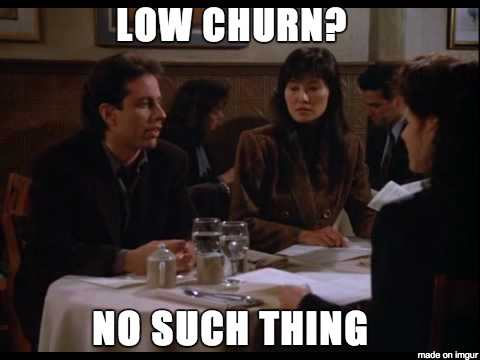 When it comes to customer churn, there are two kinds: avoidable and unavoidable.
When it comes to customer churn, there are two kinds: avoidable and unavoidable.
But I guarantee that the amount you label as “unavoidable” is actually much smaller than you think.
I know, but…
“Most of our churn is out of our control, so it’s unavoidable”
“We sell to SMB and in that market churn is inevitable.”
Accepting that churn is inevitable since x% of companies fail every year is like saying why workout, you’re just gonna die anyway.
But the excuses continue…
“We have a low price, so of course we have high churn.”
“We sell to [a certain market segment] so of course churn is high. That’s just how this works.”
“We sell to a very transient market, so of course churn is inevitable”
Unavoidable. Inevitable.
To paraphrase a monologue from a classic Seinfeld episode:
 “No matter how desperate we are that someday a better customer will emerge, with each notice of cancellation, we know it’s not to be; that for the rest of this sad, wretched pathetic quarter, this is who we sell to, to the bitter end. Inevitably, irrevocably; low churn? No such thing.”
“No matter how desperate we are that someday a better customer will emerge, with each notice of cancellation, we know it’s not to be; that for the rest of this sad, wretched pathetic quarter, this is who we sell to, to the bitter end. Inevitably, irrevocably; low churn? No such thing.”
SO MANY SaaS – and other types of companies – make this costly assumption, so let’s dig into why this is a dangerous myth.
Time to Reevaluate Unavoidable Churn
It’s very easy to fall into the “unavoidable churn” trap, but you must resist it at all costs.
Which means you can’t blindly accept any churn as “unavoidable.”
You have to challenge that notion every time it surfaces.
In fact, anytime you find yourself saying churn is unavoidable, put a dollar in your “unavoidable churn” pizza fund jar and then go research whether your assumption is correct or not.
In my experience, actual unavoidable churn is much lower than most people think; not sure why it is, but for some reason we generally accept that churn just happens.
That isn’t to say that some churn doesn’t happen, or that a portion isn’t truly unavoidable – it does and it is – but churn will happen a lot less if you figure out the root cause and do the things necessary to keep it from happening in the first place.
it’s only once you truly understand this that you can realistically – and effectively – apply the Churn Classification Framework For Customer Success Management.



